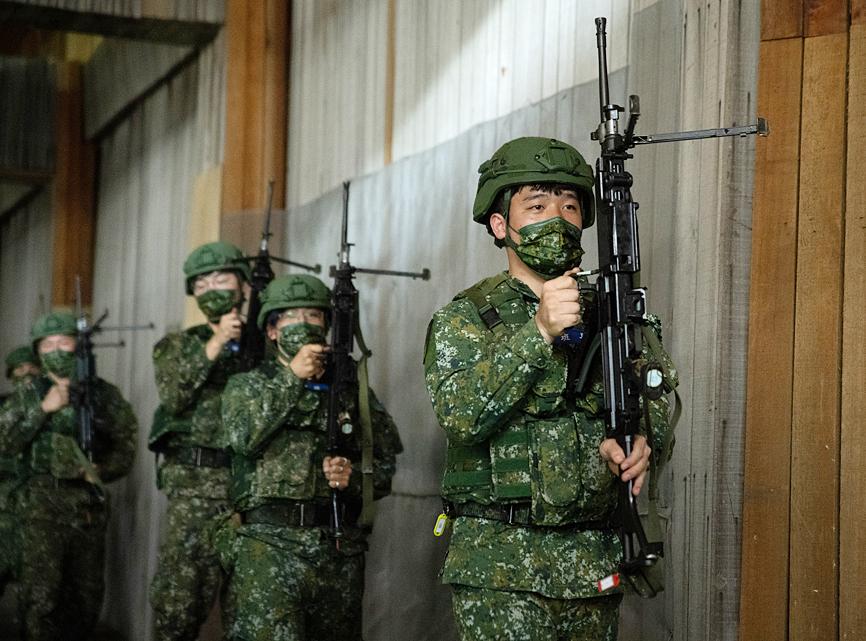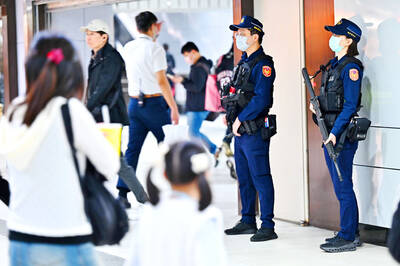The Economist yesterday said that “promises to fight for Taiwan” are an ineffective deterrent and could instead lead to a diplomatic fallout with Beijing, something that could be avoided by taking practical action to strengthen Taiwan’s self-defense capabilities.
The 180km-wide Taiwan Strait and the US military stand as the two main components deterring Beijing from attacking Taiwan, but Beijing is working to overcome both obstacles, the weekly said, adding that some US generals have said that Beijing could attack Taiwan by 2030.
The article, titled “How to deter China from attacking Taiwan,” says Taiwan, the US and its allies must learn the lessons of Russia’s invasion of Ukraine — the most important of which is that “the threat is real.”

Photo: CNA
Instead of brainstorming for strategies during battle, it behooves the US and Taiwan to prepare now, the article said, adding: “The more prepared Taiwan is for the attack, the lesser the chances that China will take the risk.”
Taiwan has made the right decision in cutting down on its reliance on conscripts and moving to increase the capabilities of a professional standing military, the article said.
Nonetheless, Taiwan should continue to provide its eligible men — and perhaps women — with military training to create a capable homeland defense force, it added.
Taiwan should increase its defense spending, as its current expenditure of 2 percent of GDP is still on the low side, the article said, citing that Israel’s defense spending amounts to 5.6 percent of GDP.
Taiwan should not expect to match Beijing in defense expenditure or the scale of available forces to be committed and should, instead, make itself a “thorny problem” for its enemies, it said.
The overall defense concept proposed by the nation’s generals in 2017 is the right path, but unfortunately, it has yet to become widely accepted by Taiwan’s military, the article said.
The concept adopts large numbers of scattered and highly mobile defense weapon platforms that are easily covered, especially anti-surface and anti-air missiles, the article said.
However, this would mean that the military would have to give up fighter jets, ships and submarines, all of which are more expensive, it added.
While being an island means it is more difficult for an enemy force to mount a successful attack, it also exposes Taiwan to the risk of being difficult to provision for, which would mean that it must fight on its own for weeks, or even months, before US military aid — which is not guaranteed — could arrive.
The longer Taiwan can hold out in the event of an assault, the more help it stands to receive, just like Ukraine, the article said.
The US should consider elevating the level of political and military interactions with Taiwan, push for more arms deal packages and step up mutual exercises, an area in which Taiwan is sorely lacking, it said.
The US should also work with Japan and other regional allies to come up with plans and conduct exercises on how to react should Taiwan be cut off or is invaded.
Such actions would inevitably anger Beijing, and US President Joe Biden should cautiously maintain a degree of “strategic ambiguity,” the article said.

TRAGEDY STRIKES TAIPEI: The suspect died after falling off a building after he threw smoke grenades into Taipei Main Station and went on a killing spree in Zhongshan A 27-year-old suspect allegedly threw smoke grenades in Taipei Main Station and then proceeded to Zhongshan MRT Station in a random killing spree that resulted in the death of the suspect and two other civilians, and seven injured, including one in critical condition, as of press time last night. The suspect, identified as a man surnamed Chang Wen (張文), allegedly began the attack at Taipei Main Station, the Taipei Fire Department said, adding that it received a report at 5:24pm that smoke grenades had been thrown in the station. One man in his 50s was rushed to hospital after a cardiac arrest

A car bomb killed a senior Russian general in southern Moscow yesterday morning, the latest high-profile army figure to be blown up in a blast that came just hours after Russian and Ukrainian delegates held separate talks in Miami on a plan to end the war. Kyiv has not commented on the incident, but Russian investigators said they were probing whether the blast was “linked” to “Ukrainian special forces.” The attack was similar to other assassinations of generals and pro-war figures that have either been claimed, or are widely believed to have been orchestrated, by Ukraine. Russian Lieutenant General Fanil Sarvarov, 56, head

SAFETY FIRST: Double the number of police were deployed at the Taipei Marathon, while other cities released plans to bolster public event safety Authorities across Taiwan have stepped up security measures ahead of Christmas and New Year events, following a knife and smoke bomb attack in Taipei on Friday that left four people dead and 11 injured. In a bid to prevent potential copycat incidents, police deployments have been expanded for large gatherings, transport hubs, and other crowded public spaces, according to official statements from police and city authorities. Taipei Mayor Chiang Wan-an (蔣萬安) said the city has “comprehensively raised security readiness” in crowded areas, increased police deployments with armed officers, and intensified patrols during weekends and nighttime hours. For large-scale events, security checkpoints and explosives

PUBLIC SAFETY: The premier said that security would be tightened in transport hubs, while President Lai commended the public for their bravery The government is to deploy more police, including rapid response units, in crowded public areas to ensure a swift response to any threats, President William Lai (賴清德) said yesterday after a knife attack killed three people and injured 11 in Taipei the previous day. Lai made the remarks following a briefing by the National Police Agency on the progress of the investigation, saying that the attack underscored the importance of cooperation in public security between the central and local governments. The attack unfolded in the early evening on Friday around Taipei Main Station’s M7 exit and later near the Taipei MRT’s Zhongshan